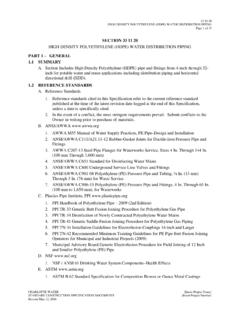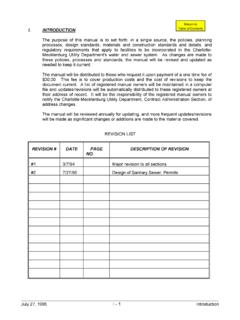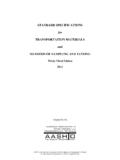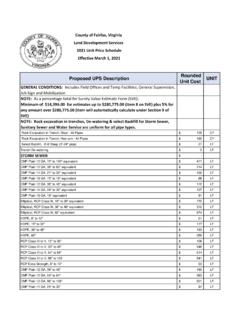Transcription of CHAPTER 5 DESIGN OF CULVERTS - Charlotte, North Carolina
1 CHARLOTTE-MECKLENBURG STORM WATER DESIGN MANUAL CHAPTER 5 DESIGN OF CULVERTS Overview .. 5-1 Definitions .. 5-1 Performance Curves .. 5-1 culvert DESIGN Procedure Flowchart .. 5-2 Purpose and Use .. 5-2 DESIGN Flowchart .. 5-2 Engineering DESIGN Criteria .. 5-3 Introduction .. 5-3 Criteria .. 5-3 Flood Frequency .. 5-4 Velocity Limitations .. 5-4 Debris Control .. 5-4 Headwater Limitations .. 5-4 Tailwater Considerations .. 5-5 culvert Inlets .. 5-5 Inlets With Headwalls .. 5-6 CHARLOTTE-MECKLENBURG STORM WATER DESIGN MANUAL Wingwalls and Aprons .. 5-7 Improved Inlets .. 5-8 Material Selection .. 5-8 Outlet Protection .. 5-8 Environmental Considerations.
2 5-8 culvert Flow and Controls and Equations .. 5-8 Introduction .. 5-8 Inlet and Outlet Control .. 5-8 Equations .. 5-9 Mild Slope .. 5-9 Steep Slope .. 5-11 "Slug" Flow .. 5-11 DESIGN Procedures .. 5-11 Procedures .. 5-11 Tailwater Elevations .. 5-12 Nomographs .. 5-12 Steps in DESIGN Procedure .. 5-14 Performance Curves .. 5-15 Roadway Overtopping .. 5-15 culvert DESIGN Example .. 5-16 Introduction .. 5-16 Problem .. 5-16 Input Data .. 5-16 Computations .. 5-17 Long Span CULVERTS .. 5-20 Introduction .. 5-20 CHARLOTTE-MECKLENBURG STORM WATER DESIGN MANUAL Structural Aspects .. 5-20 Hydraulic Considerations .. 5-20 Construction and Maintenance Considerations.
3 5-20 Appendix 5A Critical Depth Charts .. 5-21 Appendix 5B DESIGN of Improved Inlets .. 5-23 Introduction .. 5-23 Outlet Control .. 5-23 Inlet Control .. 5-23 Common Entrances .. 5-23 Capacity Determinations .. 5-24 Improved Inlets .. 5-24 Beveled-edged Inlets .. 5-25 Side-tapered Inlets .. 5-25 Slope-tapered Inlets .. 5-26 Improved Inlet Performance .. 5-26 Appendix 5C Conventional Nomographs .. 5-28 CHAPTER 5 DESIGN OF CULVERTS 5-1 OVERVIEW Definitions CULVERTS are structures used to convey surface runoff from one side of the road to another and are usually covered with an embankment composed of structural material around the entire perimeter, although some are supported on spread footings with the streambed serving as the bottom of the culvert .
4 For economy and hydraulic efficiency, CULVERTS should be designed to operate with the inlet submerged during flood flows, if conditions permit. Cross-drains are those CULVERTS and pipes that are used to convey runoff from one side of a roadway to another. Performance Curves Performance curves should be developed for all CULVERTS for evaluating the hydraulic capacity of a culvert for various headwaters. These curves will display the consequences of high flow rates at the site and any possible hazards. Sometimes a small increase in flow rate can affect a culvert DESIGN . If only the DESIGN peak discharge is used in the DESIGN , the engineer cannot assess what effect increases in the essential DESIGN discharge will have on the culvert DESIGN .
5 CHARLOTTE-MECKLENBURG STORM WATER DESIGN MANUAL 5-2 culvert DESIGN PROCEDURE FLOWCHART Purpose and Use The purpose of the culvert DESIGN procedure flow chart is to show the relationship between the different stages in culvert DESIGN and the alternatives that should be considered. DESIGN Flowchart Site Data Acquisition Hydraulic Analysis culvert DESIGN Is storm drain and pavement DESIGN needed? Is open channel DESIGN needed? Storm drain and pavement DESIGN ( CHAPTER 4) Open Channel DESIGN ( CHAPTER 3) Are improved inlets going to be used? Is routing needed? Is an energy dissipater needed? Is sediment control needed? DESIGN Documentation Improved inlet DESIGN Storage or channel routing analysis ( CHAPTER 6) Energy dissipater DESIGN ( CHAPTER 7) Sediment and erosion control No No No No No No Yes Yes Yes Yes Yes Yes CHAPTER 5 DESIGN OF CULVERTS 5-3 ENGINEERING DESIGN CRITERIA Introduction The DESIGN of a culvert should take into account many different engineering and technical aspects at the culvert site and adjacent areas.
6 The following DESIGN criteria should be considered for all culvert designs where applicable. Criteria Engineering Aspects Flood frequency Velocity limitations Site Criteria Needed length and available slope Debris control DESIGN Limitations Headwater Tailwater conditions Ground cover Utility conflicts Regulated floodway requirements DESIGN Options culvert inlets Inlets with headwalls Wingwalls and aprons Improved inlets Material selection culvert skews culvert sizes Other DESIGN Considerations Weep holes Outlet protection Erosion and sediment control Environmental considerations Some culvert designs are relatively simple involving a straight-forward determination of culvert size and length.
7 Other designs are more complex where structural, hydraulic, environmental, or other considerations must be evaluated and provided for in the final DESIGN . The following sections discuss each of the above criteria as it relates to culvert siting and DESIGN . CHARLOTTE-MECKLENBURG STORM WATER DESIGN MANUAL 5-4 Flood Frequency The appropriate flood frequency for determining the flood carrying-capacity of a culvert is dependent upon: the level of risk associated with failure of the culvert crossing; and the level of risk associated with increasing the flood hazard to upstream (backwater) or downstream (redirections of floodwaters or loss of attenuation) properties.
8 For specific DESIGN storm frequencies for culvert crossings, reference Section , DESIGN Frequencies. Also, in compliance with the National Flood Insurance Program, it is necessary to consider the 100-year frequency flood at locations identified as being special flood hazard areas. The DESIGN engineer should review the City and County floodway regulations for more information related to floodplain regulations. Velocity Limitations Both minimum and maximum velocities should be considered when designing a culvert . The maximum velocity should be consistent with channel stability requirements at the culvert outlet. As outlet velocities increase, the need for stabilization at the culvert outlet increases.
9 If velocities exceed permissible velocities for the various types of nonstructural outlet lining material available, the installation of structural energy dissipaters is required. Debris Control In designing debris control structures it is recommended that the Army Corps of Engineers, Hydraulic Engineering Circular No. 9 entitled Debris Control Structures be consulted. Headwater Limitations The allowable headwater elevation is determined from an elevation of land use upstream of the culvert and the proposed or existing roadway elevation. Headwater is the depth of water above the culvert invert at the entrance end of the culvert . The following criteria related to headwater shall be used (based on the DESIGN storm event): The allowable headwater for DESIGN frequency conditions should allow for the following upstream controls.
10 O 12-inch freeboard for CULVERTS up to 3 feet in diameter o 18-inch freeboard for CULVERTS larger than 3 feet in diameter o Upstream property damage o Elevations established to delineate flood plain zoning o Low point in the road grade that is not at the culvert location o Ditch elevation of the terrain that will permit flow to divert around culvert o HW/D The headwater should be checked for the 100-year flood to ensure compliance with the locally adopted floodway ordinance and 100 + 1 criteria. The maximum acceptable outlet velocity should be identified. Either the headwater should be set to produce acceptable velocities, or stabilization or energy dissipation should be provided.















